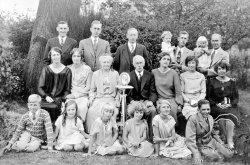
MAY CONTAIN NUTS

Search Shorpy
SHORPY ART

Framed or unframed, desk size to sofa size, printed by us in Arizona and Alabama since 2007. Explore now.
Join and Share
Ad-Free Shorpy
Shorpy is funded by you. Patreon contributors get an ad-free experience.
Learn more.

Recent comments
- Freeze Frame
- Texas Flyer wanted
- Just a Year Too Soon
- WWII -- Replacing men with women at the railroad crossing.
- Yes, Icing
- You kids drive me nuts!
- NOT An Easy Job
- I wonder
- Just add window boxes
- Icing Platform?
- Indiana Harbor Belt abides
- Freezing haze
- Corrections (for those who care)
- C&NW at Nelson
- Fallen Flags
- A dangerous job made worse
- Water Stop
- Passenger trains have right of way over freights?
- Coal
- Never ceases to amaze me.
- Still chuggin' (in model form)
- Great shot
- Westerly Breeze
- For the men, a trapeze
- Tickled
- Sense of loneliness ...
- 2 cents
- Charm City
- What an Outrage
- Brighton Park
Member Photos
The Shorpy
Print Emporium
Print Emporium
Search Shorpy
Search results -- 30 results per page
- Anthony's Wireless Airship: 1912
- ...
Delightful article from July 1910, reprinted in new Zealand. A lot more detailed than you usually got in those days. The ... Posted by Dave - 08/04/2012 - 2:17pm -
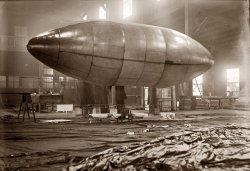
- Iron Pony: 1905
- New Zealand circa 1905. "E class locomotive, E 66, at the Petone Railway Workshops, ... Posted by Dave - 06/11/2014 - 9:17pm -
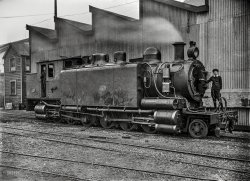
- Bed and Breakfast: 1939
- ... - Dave]
Coal Gas Smell The South Island of New Zealand continued to produce coal gas into the 1980s in Dunedin, Christchurch ... Posted by Dave - 09/21/2017 - 8:56am -
![Bed and Breakfast: 1939 July 1939. "Washington, D.C. — Government worker's room." Equipped with a kerosene stove. Medium format negative by David Moffat Myers. View full size.
Take your LumpsThat mattress is making my back hurt just by looking at it.
The stove... is an Ivanhoe "Perfection" made in Cleveland, likely in the mid-1930s.
[Or perhaps made by the Florence Stove Company of Gardner, Mass. - Dave]
Gas JetSure looks like a gas connector just above the right side of the stove. Wonder if that was only for gas light? Why was it on the wall? If it was for a heater, that connector would have been mounted down on the floor.I can remember gas valves like that with a rubber hose connected to a gas heater in bathrooms, living rooms, or other rooms that needed some extra heat. Not very safe but it was used extensively.
So efficientYou can practically cook your own breakfast in bed!
[I am stealing your idea for the title of this post. Well done and over easy! - Dave]
Odd no flue or chimney ventTank on the left was for the coal oil as we called it when I grew up. You can see the fuel line to stove. Beautiful kerosene can with wooden handle and its partner the funnel filled the tank.
Heck of a lampshadeNo fire hazard there in the breakfast nook.
Gas and KeroseneI think if you look very closely next to the alarm clock, you will see the edge of a second gas fixture that was probably left over from a pair of gas wall sconces for lighting.
Obviously, this room was converted into a bed-sit room from a single-family home with the stove added as an afterthought (probably to increase the rent obtained from the room).
Interesting that in spite of the proximity of gas lines, they chose to install a kerosene cooking stove, probably because it required no other plumbing. You can see the kerosene can sitting under the store. It was probably up to the renter to supply the fuel.
[Those jets are relics of the gaslight era, when coal gas was a primary source of illumination in many cities. With natural gas coming into wide use in the 1940s, Washington Gas Light ended production of "city gas" (which was extremely poisonous) and scrapped its distribution system of holding tanks and pipelines. - Dave]
Coal Gas SmellThe South Island of New Zealand continued to produce coal gas into the 1980s in Dunedin, Christchurch and Invercargill. When our family lived in Melbourne in the 1960s, coal gas was still in use. There is an easy way to tell you what coal gas smelled like: moth balls! And it was more explosive than natural gas. When you lit the burner, it ignited with quite a sharp "POP" sound.
(The Gallery, D.C., David Myers)](https://www.shorpy.com/files/images/SHORPY-8b15289a.thumbnail.jpg)
- Custom Bodies: 1924
- ... drive? Are they, or were they, part of an export order to New Zealand or Australia, where big custom-bodied American limousines were favored ... Posted by Dave - 01/21/2016 - 1:37pm -
![Custom Bodies: 1924 San Francisco, 1924. "Pierce-Arrow autos at Gillig Bros." Specialists in Body Building, Seat Covers, Auto Painting and Upholstery. Now playing at the Royal: "Single Wives." 5x7 glass negative by Christopher Helin. View full size.
Gillis Brothers.They later moved out to Hayward. I rode on many of their school buses back in the day.
Google eyesYou can always spot a Pierce-Arrow by the headlamps built into the front fenders. Definitely a car for the well-to-do, even if they were regular factory models.
[The ones here seem to have been stretched, with an extra row of seats. - Dave]
2015 GilligStill in business, but vehicle is a bit larger!
Crown or GilligIf you rode a school bus in the last 40 years on the West Coast, it was either one or the other.
Pass on the MoviesPhotoplay does not think much of the films at the Royal:
Single Wives -- Once again the wife-neglected-by-her-business-mad-husband theme reappears...Reminiscent of a thousand films and has as its only interest the orchidaceous Corrine Griffith. Considerable bad acting surrounds her. (Photoplay, October 1924)
For Sale -- Stock Plot 2A: the girl who is put upon the matrimonial auction block to save her bankrupt father....Obvious tale with artificial "big scenes". (Photoplay, September 1924)
Right-hard drive?Why are all three of these vehicles right-hand drive? Are they, or were they, part of an export order to New Zealand or Australia, where big custom-bodied American limousines were favored for use on sparsely populated and largely unpaved rural routes? The rear two cars, at least, seem to have more than the normal amount of ground clearance, which suggests that they might be, or have been, intended for export to Down Under.
The photos are not reversed; the signage on the building and the license plates read normally, and the car in the background is (as one would expect in the USA) left-hand drive.
Is There Something Missing from the Fire Escape?How would one get to the sidewalk from the lower fire escape platform ?
Most I've seen have a vertical ladder which slides down or a stairway which pivots down, both with counterweights to hold them in the up position.
John Ruth
(The Gallery, Cars, Trucks, Buses, Chris Helin, San Francisco)](https://www.shorpy.com/files/images/SHORPY-878.thumbnail.jpg)
- Sign Here: 1924
- ... to Joseph’s giant books of autographs.
New York Times, September 2, 1923.
Autograph Collector Here in World ... he returned to his wanderings and visited Australia, New Zealand, China, Japan, India, Egypt, the Holy Land and South Africa.
... Posted by Dave - 02/08/2015 - 1:09am -
![Sign Here: 1924 UPDATE: This is the Croatian-American "world walker" Joseph (Josip) Frank Mikulec. More here and here. And here.
August 6, 1924. "Joseph Frank [illegible] at White House with album for autographs." His pencil, however, was not allowed in. View full size.
Joseph Frank Mikulec
No word on what happened to Joseph’s giant books of autographs.
New York Times, September 2, 1923.
Autograph Collector Here in World Tours
Joseph Mikulec, autograph collector, has covered several hundred thousand miles and twice traveled around the world to get signatures of prominent persons in all countries. In travel-stained clothes and with his huge book strapped upon his back, he went to City Hall a few days ago and got the signature of Mayor Hylan.
After visiting several local celebrities in financial circles, Mikulec started West again. His leather-bound book, which weighs fifty-seven pounds, is the second he has carried to the far corners of the world. In it he proudly exhibits the signatures of five Presidents—Theodore Roosevelt, William H. Taft, Woodrow Wilson, Warren G. Harding and Calvin Coolidge. The book is heavy with seals of many States and cities, and contains the names of Lloyd George, Lord Curzon, the Prince of Wales, Prince Lubormirski, the President of China, Admiral Togo of Japan, J. Pierpont Morgan, a long list of United States Senators, American Ambassadors, Ambassadors to the United States and many editors and noted writers.
Mikulec left his home in Stubica, Croatia, twenty-two years ago, when he was 23 years old, and began his long pilgrimage on foot, traveling from city to city in Central Europe. After several years of incessant travel on the Continent he visited the United States, making his home in Philadelphia and becoming a citizen in December, 1910. Later he returned to his wanderings and visited Australia, New Zealand, China, Japan, India, Egypt, the Holy Land and South Africa.
Mikulec said he was now about ready to settle down. He hoped to see his autograph books placed in a position of honor in a museum. Then, he said, he would get a small farm of his own somewhere in the Middle West.
The Baltimore Sun, July 1928.
Tracking down the Autograph
… The enlightened collector seeks items which stir his feelings for the past. This change in the aim of autograph collecting has been the tragedy of one man, Joseph Frank Mikulec, who twenty-nine years ago started around the world collecting the autographs of the great ones of every land. When he ran out of money he painted portraits, houses and landscapes until he had a stake for his next pilgrimage. As he circumpedaled the globe his album grew until it became a sort of great register of the noted men and women of the nineteenth century. Mikulec developed a set of Atlas-like shoulder muscles from packing his giant album on his back. Finally, when he found himself staggering under the fifty-eight pounds of autographs, he had a perambulator made and today he wheels his life work about. A generation ago his book might have been a treasure, but today dealers are not interested.
Trend SetterAbout fifty years thence, his carry style would make a big hit with owners of portable stereos.
Dream StirringI'm really disappointed the book is missing because this post really piqued my interest. I think to view it would be utterly fascinating the way Mikulec attached notes, photos, seals and postage stamps of the people concerned.
I need to do some researchI'd be interested to see if he's in our family tree somewhere down the line. My dad's parents emigrated from that area back before World War 2.
(The Gallery, D.C., Natl Photo)](https://www.shorpy.com/files/images/SHORPY-26031u1.thumbnail.jpg)
- Ahoy, Matey: 1921
- ... two countries. The photo below shows the ship departing New South Wales sometime in the 1920s.
A passenger who contracted ... aide of the sinking ship RMS Tahiti, on voyage between New Zealand and San Fransisco. Ventura picked up all of the passengers after they ... Posted by Dave - 04/14/2017 - 5:45pm -
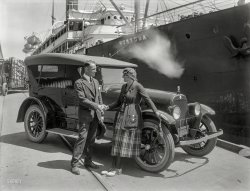
- Odd Jobs: 1902
- ... delighted to have your sister or daughter to tea."
New Zealand circa 1902. "Three men at campsite doing odd jobs, showing one man ... Posted by Dave - 04/06/2014 - 10:26am -
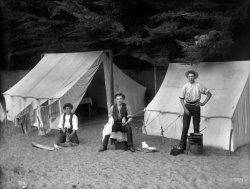
- The Whole Fam Damily: 1927
- ... of the Lusitania. Some of the family moved to Canada or New Zealand, but most stayed in England. I wish I’d been able to know them ... Posted by Rute Boye - 09/28/2012 - 8:17pm -
